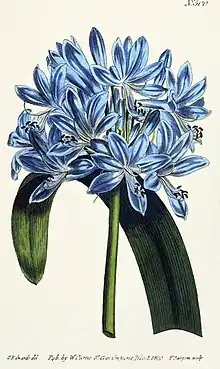Agapanthus africanus
Agapanthus africanus (African lily) is a flowering plant from the genus Agapanthus native to the area of Cape of Good Hope in South Africa.[2] A. africanus is more difficult to grow in gardens than A. praecox, and almost all plants sold as A. africanus are actually A. praecox.[3]
| African lily | |
|---|---|
 | |
| Scientific classification | |
| Kingdom: | Plantae |
| Clade: | Tracheophytes |
| Clade: | Angiosperms |
| Clade: | Monocots |
| Order: | Asparagales |
| Family: | Amaryllidaceae |
| Subfamily: | Agapanthoideae |
| Genus: | Agapanthus |
| Species: | A. africanus |
| Binomial name | |
| Agapanthus africanus (L.) Hoffmanns. | |
| Synonyms[1] | |
| |
It has a short stem bearing a tuft of long, narrow, arching leaves 10–35 cm long and 1–2 cm broad, and a central flower stalk 25–60 cm tall, ending in an umbel of 20-30 white, or bright blue, funnel-shaped flowers, each flower 2.5–5 cm diameter.[4][5]
Cultivation
It was introduced to Europe at the close of the 17th century.[3] Unlike the more common A. praecox, it is not generally suitable as a garden plant, and will not tolerate extended freezing temperatures.[3]
See also
References
- "The Plant List: A Working List of All Plant Species". Retrieved April 3, 2014.
- Kew World Checklist of Selected Plant Families
- PlantZAfrica: Agapanthus africanus
- Hoffmannsegg, Johann Centurius von. 1824. Verzeichniss der Pflanzenkulturen 35. Agapanthus africanus
- Linnaeus, Carl von. 1753. Species Plantarum 1: 292, as Crinum africanum
- Bailey, L. H. (1920). Manual of Gardening, a Practical Guide to the Making of Home Grounds (2nd ed.). New York: Macmillan. OCLC 2481316. Project Gutenberg Literary Archive Foundation.
External links
- Plantweb: Agapanthus africanus
- Dressler, S.; Schmidt, M. & Zizka, G. (2014). "Agapanthus africanus". African plants – a Photo Guide. Frankfurt/Main: Forschungsinstitut Senckenberg.
This article is issued from Wikipedia. The text is licensed under Creative Commons - Attribution - Sharealike. Additional terms may apply for the media files.